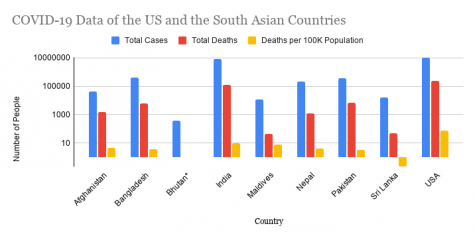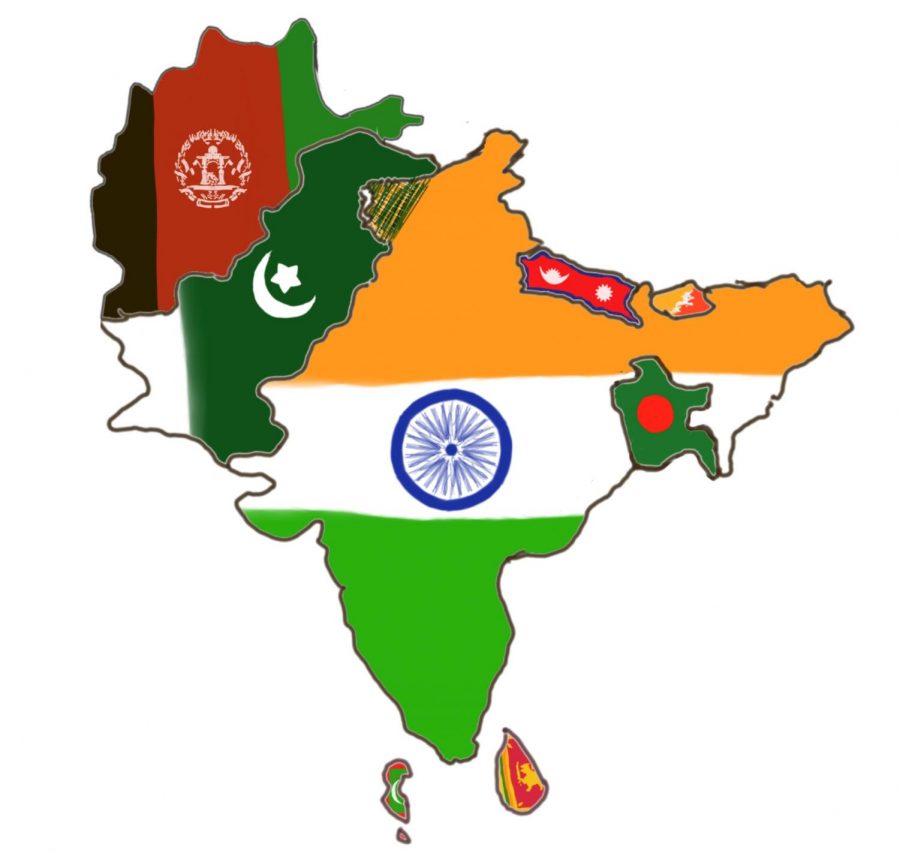The Coronavirus Pandemic in South Asia
The COVID-19 virus has had a wide range of impact on South Asian countries.
The countries of South Asia are represented on this map by their national colors: Afghanistan, Bangladesh, Bhutan, India, Maldives, Nepal, Pakistan, and Sri Lanka.
The number of new COVID-19 cases are currently increasing in the eight countries of South Asia: Afghanistan, Bangladesh, Bhutan, India, the Maldives, Nepal, Pakistan, and Sri Lanka. After the COVID-19 virus was discovered, the United States of America adopted loosely enforced regulations, but South Asia quickly settled into lockdowns and quarantines, and the response has varied from country to country. While the novel Coronavirus is just as dangerous today as it was in February 2020, some of these countries are considering whether or not they should push back their COVID-19 mitigation policies. Despite the rising numbers, countries such as India and Pakistan have either ended their national lockdowns, or reduced their regulations. Other countries, such as Bhutan and Sri Lanka, continue to adopt strict measures in order to combat the spread of the Coronavirus.
Afghanistan has approximately four hundred thousand reported cases of COVID-19. Plagued by political instability and a weak economy, the country is vulnerable to infections because its medical facilities and equipment are dangerously underfunded and inadequate. Peace negotiations between the Taliban and the Afghani Government have failed to produce any substantial agreements, leading to even more political instability that has worsened the public health response. Although donations were made by several of Afghanistan’s allies, The World Bank, and other organizations to try to help manage the Coronavirus pandemic, the political disunity within the Afghani Government reduced their allocative efficiency. As of November 12th, 2020, Afghanistan’s reported death count is 1,581 individuals, pulling its case-fatality to 3.7%, the highest in South Asia.
On September 11th, 2020, Pakistan’s total count of COVID-19 positive cases surpassed three hundred thousand, and it continues to grow as the Pakistani Government downplays the danger of the virus. In the summer of 2020, for instance, the Government allowed mosques to hold large gatherings after it was pressured by influential religious figures. Although numbers from Our World In Data, a publication based on the Oxford Martin Programme on Global Development, show that the daily positive rate of COVID-19 testing has dropped from 22.4% on June 4th, 2020 to about 4.7% on November 21st, 2020, some believe that this lowered rate is a consequence of insufficient testing, since many people who are positive for the Coronavirus cannot get a test, driving down the rate of positivity. Pakistan’s case-fatalities is 2.1%, the second highest of South Asia, with over six thousand deaths.
India, home to 1.3 billion people, is also the home of more than 8 million positive Coronavirus cases. As of November 12th, 2020, it is the second largest count in the entire world. Overpopulation and unsanitary conditions rendered it nearly impossible for the Indian government to stop the spread of the Coronavirus, even after placing a mandatory lockdown in March 2020 to “break the chain of infection,” as Prime Minister Narendra Modi was quoted as saying in a Washington Post article. The lockdown, however, caused extreme damage to India’s economy. The people hardest hit by the shutdown protested against social distancing measures and refused to get tested, fearing that they would lose the jobs that support them. Compared to the volume of its population, India is poorly prepared for a confrontation against the Coronavirus because of the shortage of beds and medical equipment. Its healthcare system accounts for only 4% of the national GDP, demonstrating its weaknesses in combating the crisis. India’s case fatality ratio is 1.5%, with nearly a hundred thousand of the infected deceased.
More than 400,000 people have tested positive in Bangladesh. Its health care system is extremely inadequate, as it comprises only about 0.69% of the national GDP. Due to the lack of resources, patients are being turned away from hospitals. Although the early lockdown was intended to curb the Coronavirus, it was done too hastily, leaving millions of people living in poverty to fend for themselves. “Provide more resources to people so that they won’t have to starve themselves through the Coronavirus pandemic,” Fatima Islam, ’24 said. She then added, “If the people were provided more support like cash assistance or food, they wouldn’t feel the need to go out and endanger themselves in order to make a living.” Bangladesh’s case fatality ratio is 1.4%, much like that of India.
Sri Lanka’s total positive cases number is less than sixteen thousand, with only forty six deceased since the beginning of the outbreak. The Sri Lankan Healthcare system is exemplary for its affordability and accessibility, contributing to its effective response. The Sri Lankan government adopted several measures after the emergence of the first positive case on January 28th 2020, including high testing rates and early lockdowns, ensuring that it had early control of the virus. Its case fatality ratio is the lowest of all of the South Asian countries, only 0.3%
Of the twelve hundred thousand infected in the Maldives, forty one of them passed away, making its case fatality ratio 0.3%, only slightly higher compared to Sri Lanka. After the Government confirmed the first coronavirus case on March 8th, 2020, the country immediately placed travel bans on countries with high infection rates, such as Italy and China, despite its heavy reliance on tourism. These measures were complemented by its naturally isolated geographical features and high testing rates comparable to those of European countries. While the government effectively prevented many deaths from the Coronavirus, the pandemic had a devastating impact on the minimally paid workers in the country. Many of the minimum-wage earners are migrant workers from nearby countries, and because of the Coronavirus pandemic, they are being laid off. Amidst the protest, the Maldives government had decided to re-open the country to tourism in October 2020, hoping to revitalize the economy.
Bhutan has the lowest count in South Asia, with only 364 infected people and zero deaths. Although its Ministry of Health is poorly equipped compared to the bordering countries, it has been able to temper the spread of the virus effectively because its government responded as early as March 22nd, 2020, by closing down the borders and implementing social distancing and quarantine measures.

The Coronavirus continues to blaze its way through every continent and its effects are evident. On the one hand, due to insufficient preparation and abrupt lockdowns, the economies of Afghanistan, Bangladesh, India, and Pakistan are left badly affected, and their people are in desperate need of change. On the other hand, Bhutan, the Maldives, Nepal, and Sri Lanka have so far curbed the growth of the Coronavirus and maintained a low case-fatality. Compared to the countries in South Asia, we in America have over 11.6 million positive COVID-19 cases and over 250,000 deaths; it appears as though these South Asian countries have fared better than us. But even though the numbers seem to suggest an optimistic turn, the future remains uncertain.
After the COVID-19 virus was discovered, the United States of America adopted loosely enforced regulations, but South Asia quickly settled into lockdowns and quarantines, and the response has varied from country to country.
Samia Sultana is a News Editor for 'The Science Survey’ who believes that journalistic writing and photojournalism shed light into the hidden corners...











